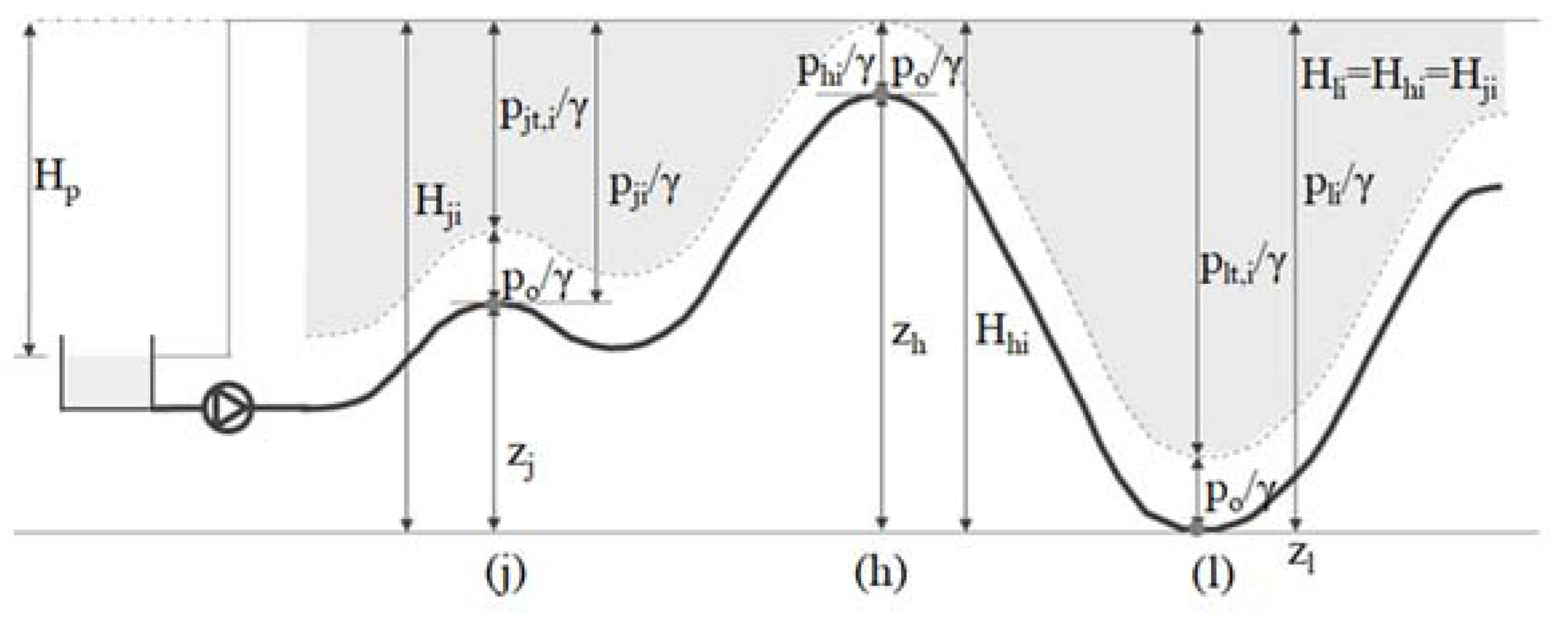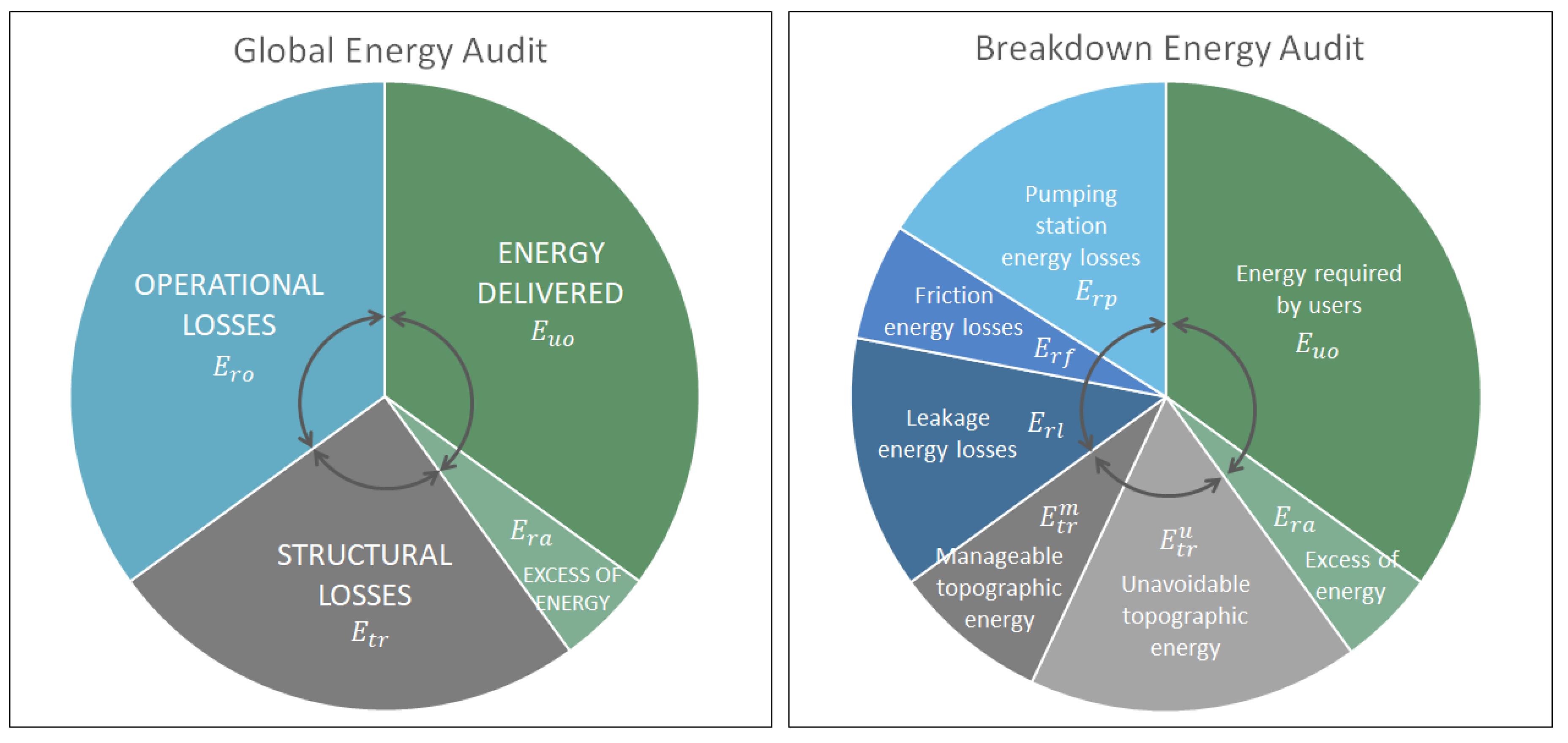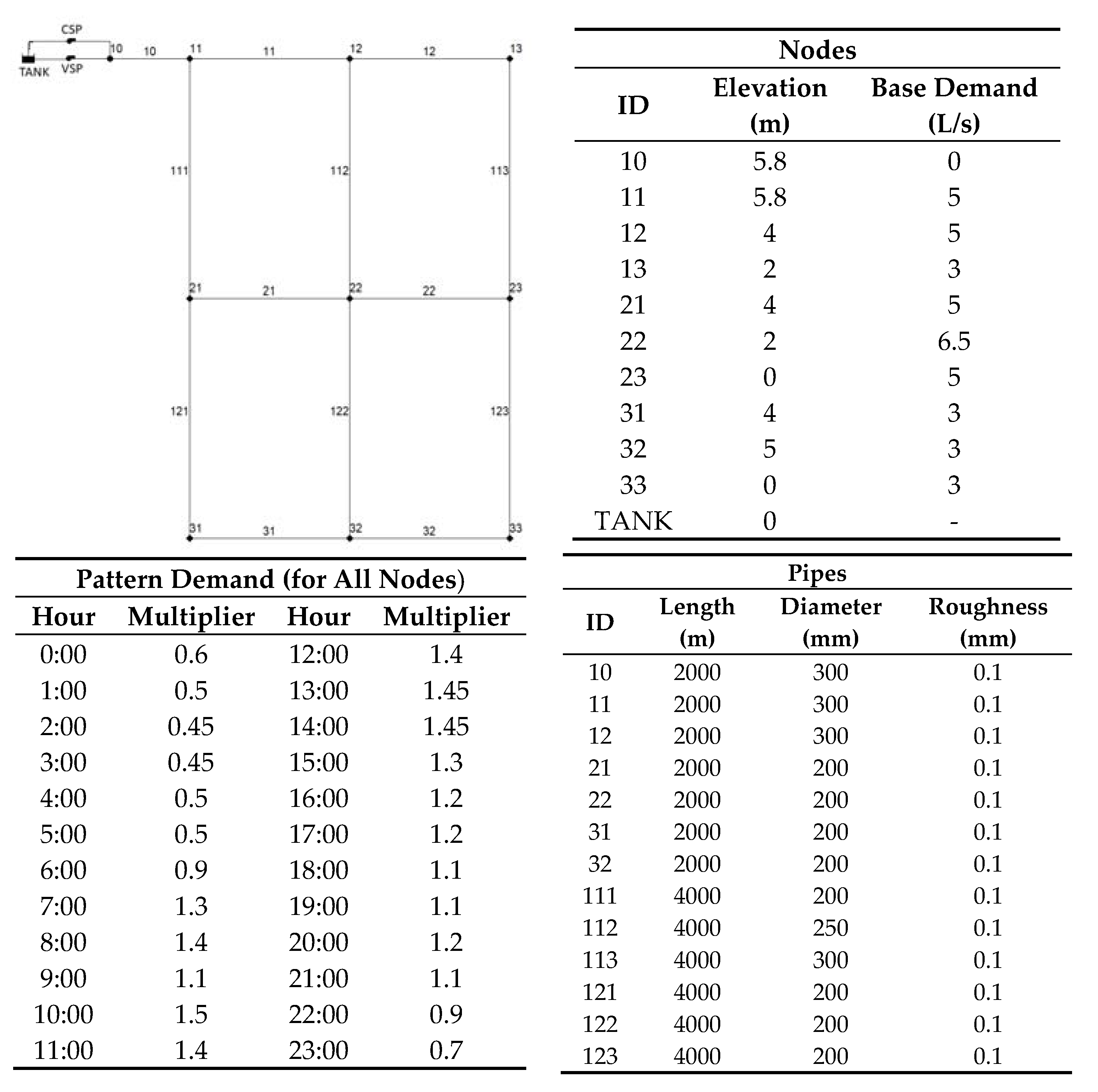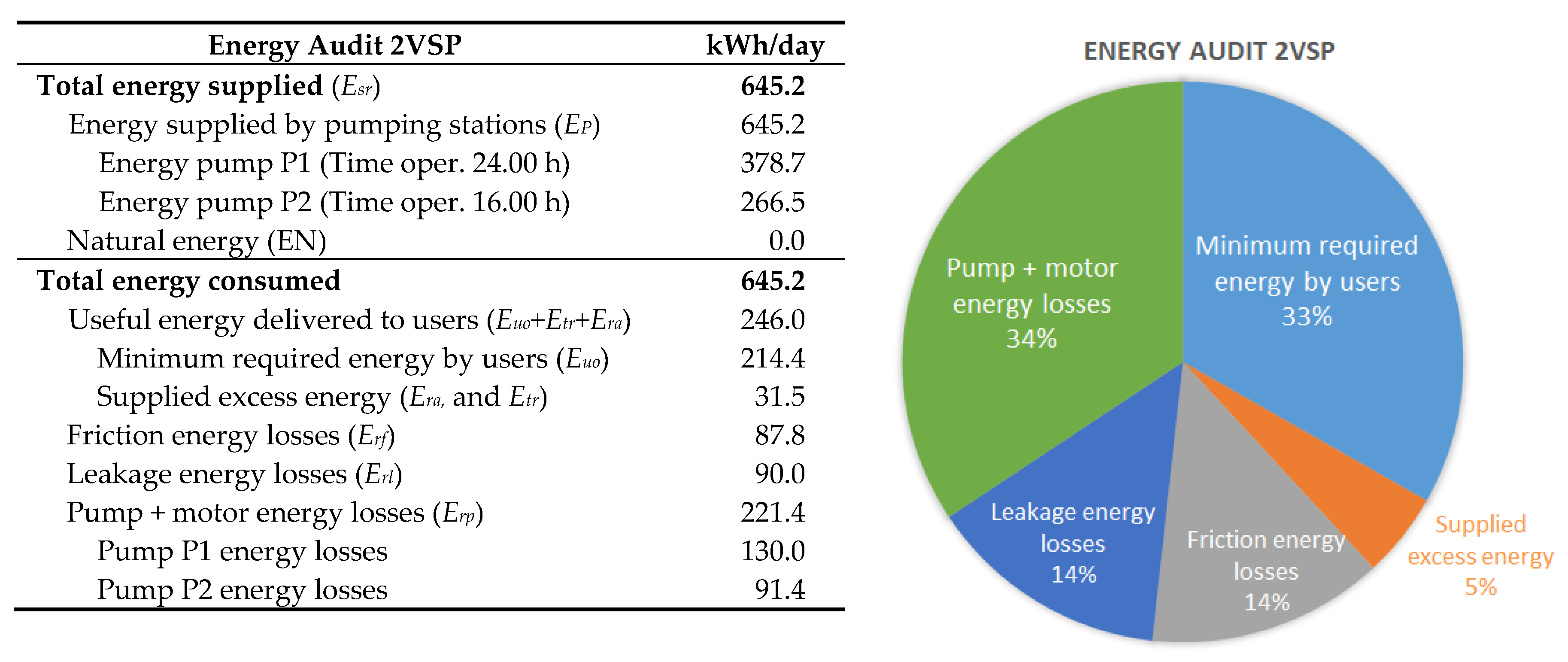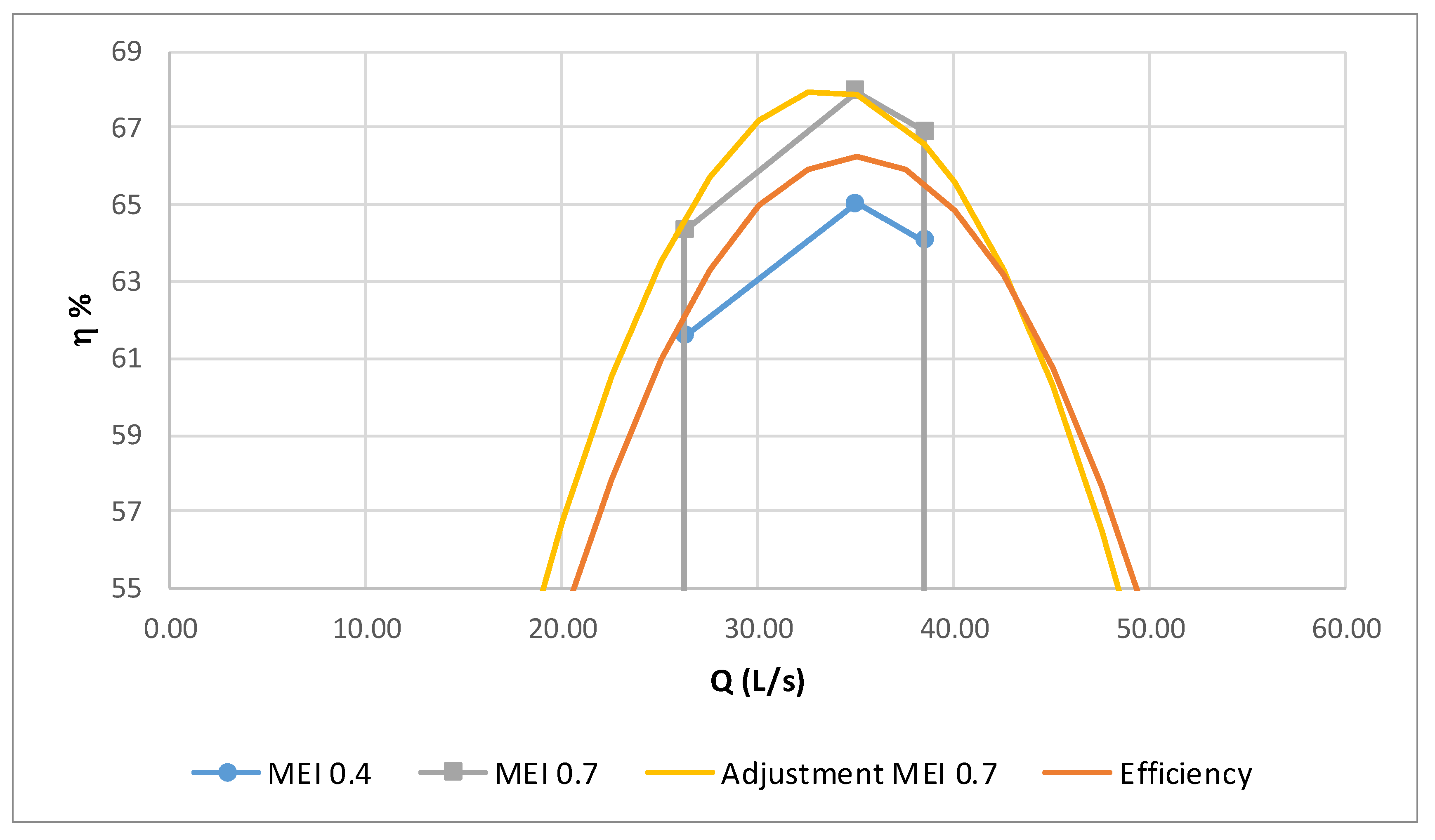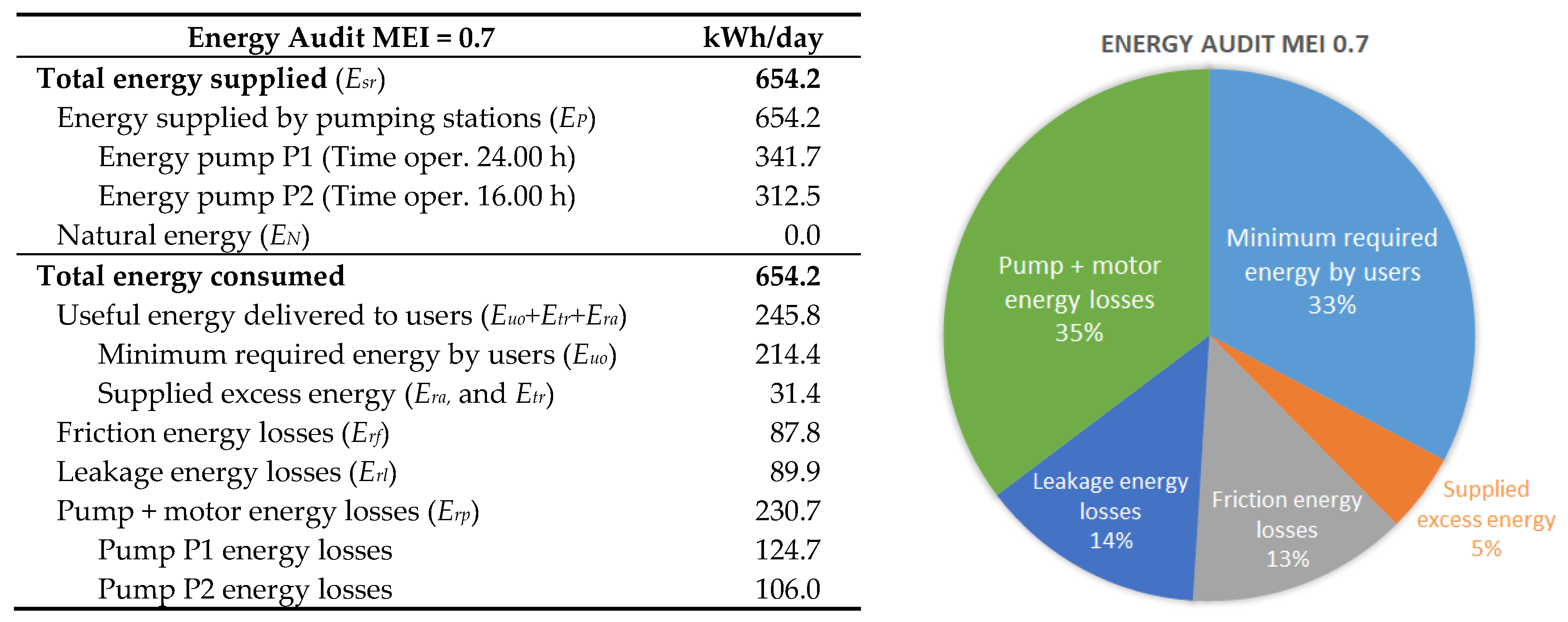1. Introduction
Most of the world’s fluid transport (measured in t × km) is via pipelines. The significant weight of fluids is a contributing factor especially for water and oil, as are the growing demand for these fluids. In Spain, for example, piped water transport accounts for 66.6% of the total, distantly followed by highway transport (28.3%) [
1]. This results in an overwhelming percentage due to an obvious fact: only fluids can be transported by pipe. Moreover, nothing suggests that this situation will decrease in the future. Therefore, more efficient piped fluid transport is required. Specific data also confirm this claim.
In fact, 6% of the total consumed electrical energy in California is due to water transport [
2], whereas in Spain, irrigation water alone accounts for 3% of the total [
3]. Logically, this energy consumption is not only due to water transport inefficiencies. Gravitational energy due to elevation changes and working pressure are also energy requirements for different usages.
To optimize Pressurized Water Transport Systems (PWTSs), work in two directions must be complete. Firstly, fostering improvement strategies from a technical point of view, such as energy efficiency diagnoses and audits on these systems, must be undertaken, as well as raising awareness among managers, which includes informing and encouraging them. This requires metrics that indicate the level of losses in managed systems are reasonable, in accordance with the current state of the art technologies and standards. This should be globally applicable and easily understood, even for people without specific technical training. This need has already been underlined [
4] but our current proposal provides further understanding. The main contribution of this paper is providing a metric that summarizes the global system energy performance, gathering together and weighting all systems’ losses, including pumping, leakage, and friction losses. Decoupled analysis of each type of loss, with their corresponding metrics, can be widely found in the literature: pumping station losses [
5,
6], leakage losses [
7,
8], pumping and leakage losses simultaneously [
9], friction losses [
10,
11], and pumping and layout (structural) losses [
12]. Conversely, pipe-level metrics are available [
13], although a global metric based on a well-funded protocol is missing, which was the main objective of this paper.
Global analysis is the only method that can be used to optimize efficiency. Pressurized water transport entails different types of inefficiencies, which have only been addressed separately to date. Efficiency of pumping systems in PWTSs is a clear example of the need to conduct extensive analyses. The European Union has fostered a directive imposing minimum pumping performance [
14]. Moreover, pump manufacturers have warned that regardless of pump efficiency, if the right pump is not fitted, performance of the assembly can still be very poor. Consequently, the scope has been extended from only considering pump performance to defining an Energy Efficiency Index (EEI), which considers the performance of the pump and the load curve assembly as a whole, within the new Extended Product Approach concept (EPA) [
6]. To maximize efficiency, the system curve must be previously optimized.
Consequently, in a global process, the first step is to analyze the system as a whole, then optimize the load system curve, and finally work downward to select the right elements. For example, if the layout is not optimum [
15], neither is the system curve nor will the system as a whole be efficient, even if the EEI and the pumping equipment are optimized. It is, therefore, necessary to perform global analyses.
The overall energy efficiency requires jointly analyzing the three parts of the system while simultaneously studying their interdependencies. These parts include the following: (1) Energy sources. Two different types can be considered: Tanks, which are rigid energy sources (RES) and pumping stations, which are variable energy sources (VES). The energy injected into the system by RES is constant, providing variations in the water tank levels are not taken into account. Energy supplied by VES can meet the system’s requirements by changing the pump’s rotational speed [
15]. (2) Piping system and other necessary elements for transporting water, i.e., from a single diameter pipeline to a complex system, with numerous nodes and loops. (3) Points of use, where transported water is delivered. The simplest case would be a tank. In an urban water network, points of use refer to users’ installations, whereas in irrigation networks, it refers to final pipes inside the plots supplying sprinklers or drip-irrigation devices.
Once these three parts have been integrated in a PWTS, they create an entire system with a specific layout, largely dependent on the topography that notably affects its energy performance. Achieving the highest efficiency is only possible from a global analysis approach, covering these three parts and without ignoring the framework where it is located.
Previous studies [
16,
17,
18] described how to perform this global analysis, whereas this article proposes partial and global metrics. The remainder of the paper is organized as follows. In
Section 2, system assessment is discussed [
16]. The difference between single pipelines and networks and between ideal and real systems are considered and results discussed. Notably, the diagnoses assess the overall energy efficiency, but without providing information on where and how much energy is lost in each phase of the PWTS. Next, the system audit is analyzed [
17]. Water and energy audits are required to identify which part of the total energy losses corresponds to each inefficiency. However, metrics are needed to assess the significance of each kind of loss, which is the objective of the next stage. Then the relevance of each kind of loss is evaluated. It is crucial to know whether these losses are excessive, reasonable, or if their current level will be difficult to improve. The proposed reference values are based on economic criteria. Finally, an equation to integrate these partial efficiencies into a single value is proposed. This score that can be used to label the system. Afterward, a simple case study to clarify the methodology is presented. This methodology can be extended to real systems following the concept herein developed. In fact, from the basic example of this paper, the energy audit of a real case (Bangkok water network) has been recently performed [
19].
2. Energy Assessment of PWTSs
Assuming no operational losses (ideal case), the following data are required to diagnose a system: (1) elevation of the water source, (2) elevation of the demand points zj with their corresponding consumed volumes vj, and (3) pressure at the delivery points. In urban networks, pressure is set by the standards, whereas in irrigation networks, it depends on the requirements of drippers or sprinklers, which is zero when a tank is filled.
The simplest case, also fairly common, is pumping water from an aquifer to a tank with a simple pipeline from source to delivery point. Assuming
H = 100 m of elevation head, a flow
Q = 0.1 m
3/s, which is 8640 m
3/day, and no pressure requirements at the delivery point (i.e., a tank), the daily consumed energy is:
Energy intensity I is measured in kWh/m3, and the relation between the energy consumed and the pumped volume is 0.2725 kWh/m3. This is the energy required to pump one cubic meter an elevation of 100 m. This is an ideal value because transport inefficiencies (friction, leaks, or pumping losses) have not been included.
The indicator generally used is 0.4 kWh/m
3 per 100 m elevation. It is assumed that friction losses are 10% of the elevation head (a rather exaggerated figure, only justifiable with long distance water transfer), a pumping efficiency of 75% (a reasonable value), and a non-leaky pipeline. Therefore:
In a previous paper [
16], this concept was generalized for water networks. Although from a conceptual point of view, the single pipeline network approach is identical, there are three differences to underline. (1) The existence of consumption points at different heights and with different demands, which introduces two new related concepts: topographic energy and structural losses. These concepts are not logical in pipelines. (2) Network water leaks in practice are unavoidable. This introduces a third type of loss in addition to those mentioned for the simple pipeline. (3) Water supplied at demand points must be delivered at a required pressure (
po/γ = ho).
As such, how to assess the performance of an ideal network is summarized. Further details are provided in a previous study [
16].
Figure 1 shows the profile of one pipe of the network that includes intermediate water consumption points. The supplied energy is conditioned by the highest node (
zh) and by the minimum pressure to deliver to users,
po/γ = ho. The heights must refer to the lowest non-zero flow node (
zl). Under these conditions, the efficiency (
ηai) is the relation between the minimum energy required to supply to consumers
Euo and the energy injected into the system
Esi:
where
and
where
V is the total volume to supply in the given period and, if there are no leaks (ideal system), is the sum of all nodal demands, (
), and
is the piezometric height of the highest node.
The ideal topographic energy
Eti can be defined as the excess of energy delivered to each node, as shown in
Figure 1, thus obtaining:
Which shows a balance: the total energy injected into an ideal system is the sum of the strictly necessary energy, plus an energy surplus, referred as topographic energy.
Notably, the concept of topographic energy is tied to two facts. First and most important, topographic energy is the link to the land topography, hence its name. With delivery nodes at different heights, this energy will always exist. Since sufficient energy must be guaranteed for the least favorable node, an excess of energy is supplied to the lower nodes. Unlike the previous operational losses, such as leaks or friction, named structural losses. The second factor is linked to RES because, when located higher than necessary, topographic energy in flat areas is generated (
Figure 2).
By combining Equations (3) and (7), the efficiency of an ideal water distribution network is obtained:
where
θti is the contribution of the structural losses in decreasing the system efficiency. The structural losses can only be reduced through layout modifications (structural actions). Strictly speaking they are not losses as such because energy is not dissipated but, they are responsible for additional energy being supplied to the system.
In real systems, the energy injected into the system is, to a greater or lesser extent, higher than
Esi.
Figure 3 shows a real system [
16] where even more pressure than the minimum required is delivered to the least favorable point. In an energy balance of a real system, the following differences apply:
- (1)
The energy Euo is identical in both cases because it only depends on the user demands and the service requirements. This is not the case for the total supplied energy in a real system Esr, which must include losses.
- (2)
The operational losses, modifying the piezometric height lines, are energy dissipated through friction in pipes and valves (Erf), energy embedded in leaks (Erl), and pumping station inefficiencies (Erp).
By merging all these real operational losses in
Ero, can be stated:
The real topographic energy
Etr (
Figure 3, shaded area) is different to the ideal
Eti.
Etr is now linked to the new real piezometric height which, with losses, is no longer horizontal. Finally, another type of energy loss exists, the real avoidable losses
Era, which are relatively common. These include excesses of energy delivered at the least favorable node (
Figure 3) and depressurization in domestic tanks.
In short, analysis of ideal systems sets the maximum values for system efficiencies. Real systems share the energy efficiency numerator (
Euo) with ideal systems, but the denominator,
Esr, is substantially different, as shown in Equation (10). That supplied energy can proceed from a RES, natural source
EN, or from a VES also called shaft energy
EP, [
17]. Therefore:
Ultimately, the real efficiency
ηar results from:
Shaft energy
EP is determined from the electricity bill, whereas natural energy
EN can be directly estimated [
17], so therefore
ηar can be calculated.
ηa is the ideal performance less the contributions of the operational losses
Ero, the structural losses
Etr represented by
θtr (topographic energy indicator), and, if any, the avoidable losses
Era.
3. Operational and Structural Losses Metrics: Final Labeling
After the assessment, the system is audited, firstly from a water point of view [
20] and then in terms of energy [
17].
Figure 4 summarizes the results for a network without domestic tanks, and therefore the only avoidable energy
Era is the excess of pressure. The left of the figure shows the general summary according to Equation (9), and the right shows the losses that have been broken down according to Equation (10). The topographic energy has also been separated. Part of this energy can be managed by recovering it with pumps as turbines (PATs) or dissipating through pressure reducing valves (PRVs), resulting in the manageable topographic energy concept,
. The complimentary term is the unavoidable topographic energy
), which will inevitably continue to be part of the system’s energy balance unless the layout is changed [
15].
The system as a whole is coupled and therefore operational losses are interdependent. Reducing leaks diminishes friction and simultaneously modifies the operating point of the pumps. However, as the losses are identified and the equations to assess them are decoupled, the losses can be calculated separately [
17]. Operational losses are produced in two of the three parts of the system. Losses occur if the energy source is a VES. The transformation of electrical energy in hydraulic energy involves losses that do not exist if the energy comes from a RES, as hydraulic energy is supplied directly without any transformation process. The other two operational losses, friction and leaks, are in the second part of the system in the network pipes, whereas structural losses are at the consumption nodes, corresponding to the third system stage.
Finally, the two kinds of avoidable losses must be considered. The first one, depressurization in domestic water tanks (if any), occurs between the second and third stages. Although there is no loss of water, this inefficiency is similar to a leak from an energy point of view, and therefore can be considered an operational loss. The second avoidable loss is delivering more energy than necessary at the least favorable point and consequently to the entire system. Removing these losses entails reviewing how the energy source works. If the energy source is a RES, the loss is unavoidable and can be classed as an additional structural loss. If the source is a VES, the loss can be minimized using variable speed pumps and should be considered an operational loss.
Once the audit has been performed, the next stage is to identify reference levels, i.e., metrics that permit assessing the relevance of each kind of loss. This allows identifying if losses are excessive, reasonable, or if they are low enough that reducing them further is not practical. This analysis is crucial to determine the priority of actions considered to improve the energy efficiency and, furthermore, to label the global efficiency of the system [
21]. The case study will show that a simple quantitative analysis without reference levels can lead to some misleading conclusions.
3.1. Energy Losses Reference Levels
The suggested reference levels are provided for operational losses and structural losses.
3.1.1. Operational Losses, Ero
Erl is the leakage energy losses. Two reference levels, the Economic Level of Leakage (ELL) [
22] and alternatively the Infrastructure Leakage Index (ILI) [
23], can be used.
Erf represents the friction losses. A previous study provided a similar metric to ELL, called the Economic Level of Friction (ELF) [
10], which can be more or less stringent by adding environmental taxes to the energy costs.
Erp represents the pumping station losses (wire to water inefficiencies), referred to the pump only, the Minimum Efficiency Index (MEI). This concept has been defined by the European Commission [
14], a criterion extended to the EEI [
6], when pumps and motor driven efficiency are considered as a part of the PWTS, such as when coupled to the system load profile. The minimum MEI considered [
14] is 0.4 and was adopted for PWTS working for a low number of hours per year (
hw), which is considered to be less than 500 h/year, such as in fire-fighting systems. For higher
hw, a MEI of 0.7 will be adopted. In this new context, with compulsory minimum efficiencies, a pump life cycle cost analysis does not make sense [
24]. Although the system’s manager can address some losses (e.g., leaks and friction), pump losses cannot be easily changed. They depend on the state of the art and on the right pump selection.
3.1.2. Structural Losses, Etr
Structural losses
Etr weighted by
θtr, the topographic energy indicator, can be split into manageable topographic energy and unavoidable topographic energy. Manageable topographic energy can be partially recovered with PATs or partially removed with PRVs [
15]. Being very much dependent on the PWTS load conditions, a reference level does not make sense. Its relevance is indicated by the manageable topographic energy indicator,
.
is unavoidable topographic energy that depends on the network’s topography. It can only be reduced by modifying the system’s layout [
15]. Being independent of the management quality, a reference level does not make sense. Its relevance is demonstrated by the unavoidable topographic energy indicator,
and
.
Lastly, avoidable losses do not require reference values. They can be, and therefore should be, zero.
3.2. Global Energy Losses Score
The next step was to calculate an energy score for the entire PWTS. The reference levels for losses provide specific values and are of a local nature since they are linked to water and energy costs and can be more or less sensitive to environmental targets by including taxes in their costs.
Table 1 summarizes these economic and environmental criteria.
Once the criteria have been established, these levels (
,
, and
) must be calculated for the analyzed system. From the energy audit, leaks and friction energy real losses,
and
are known, respectively (
Figure 4, right). From the ELL, the economic level of leaks concept,
is determined, whereas from the ELF procedure, the optimum average unitary head loss,
, is calculated. With the present level of leaks
and actual average friction
Ja, the reference values
and
can be finally determined, respectively, according to:
However,
El,e cannot be directly determined because it depends on the adopted MEI and on the system’s characteristic load. It must be calculated from the mathematical model of the network. Equation (13) summarizes this result:
The global economic energy loss reference
is determined with:
whereas the score for the proposed global energy index
IS is:
where
γl,
γf, and
γp are the weighting factor of leakage, friction, and pump losses, respectively. The optimum value of
IS is one. The higher the value of
IS, the worse the score.
This global energy score
IS represents the weighted operational losses efficiency. Without structural losses metrics, three context performance indicators can be used to provide an idea of its relevance. Two of these indicators,
and
, or their complementary value
, have been previously defined. The third indicator
C1 clarifies the origin of the energy (natural or shaft) and is given by
C1 = EN/Esr [
17]. Ultimately,
,
and
C1 provide clear information about the relevance of the structural losses and the potential for their reduction. To summarize, the operational losses global score in Equation (15) indicates the efficiency of a PWTS, and could be the basis for a final label, whereas the three structural parameters provide clear information about the framework in which the system operates.
5. Conclusions
The process to improve the PWTS energy efficiency can be performed in three different stages. First, the diagnosis must be completed to calculate the global losses. Second, the audit is performed to break down these losses to calculate their specific weight. The third step, which was the focus of this study, was to assess the margin for improvement in the system by determining the values losses should have from an economic standpoint. By comparing the actual losses with the calculated reference values, the margin for improvement for each component can be estimated. This relative value is more illustrative than the global quantity, as demonstrated by the case study.
Calculating the reference values for friction and leakage operational losses can be directly estimated. However, they are dependent on the load system curve and not on the pumps. As such, an audit with the new pumps was performed in this case. Regardless, it is showed that the difference obtained when friction and leakage improvements were assessed does not justify such a considerable effort. Ultimately, IS is just an indicator.
The combination of all operational losses in a final score, obtained by combining the improvement margin for each loss with their specific weights, is a clear global efficiency indicator of an operating system. Finally, based on this result, the efficiency of the system as a whole was labeled, being this the main achievement of this paper. In the case study, this margin for improvement was around 40%, relatively small because the energy consumed by the pumps, accounting for 74% of the total operational losses, was only slightly higher (around 11%) than if pumps with MEI 0.7 and IE3 motor drivers were used. More efficient pumps than MEI 0.7 are difficult to find on the market [
16]. In systems with bigger pumps, higher improvements could be achieved because pumping efficiency is closely linked to the power of the pumps, which were rather low in this case study.
